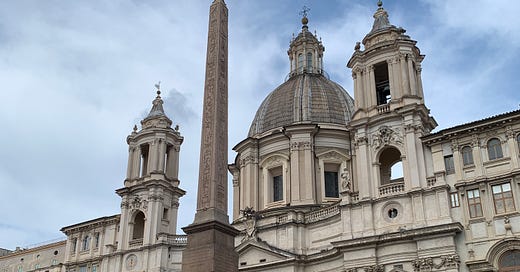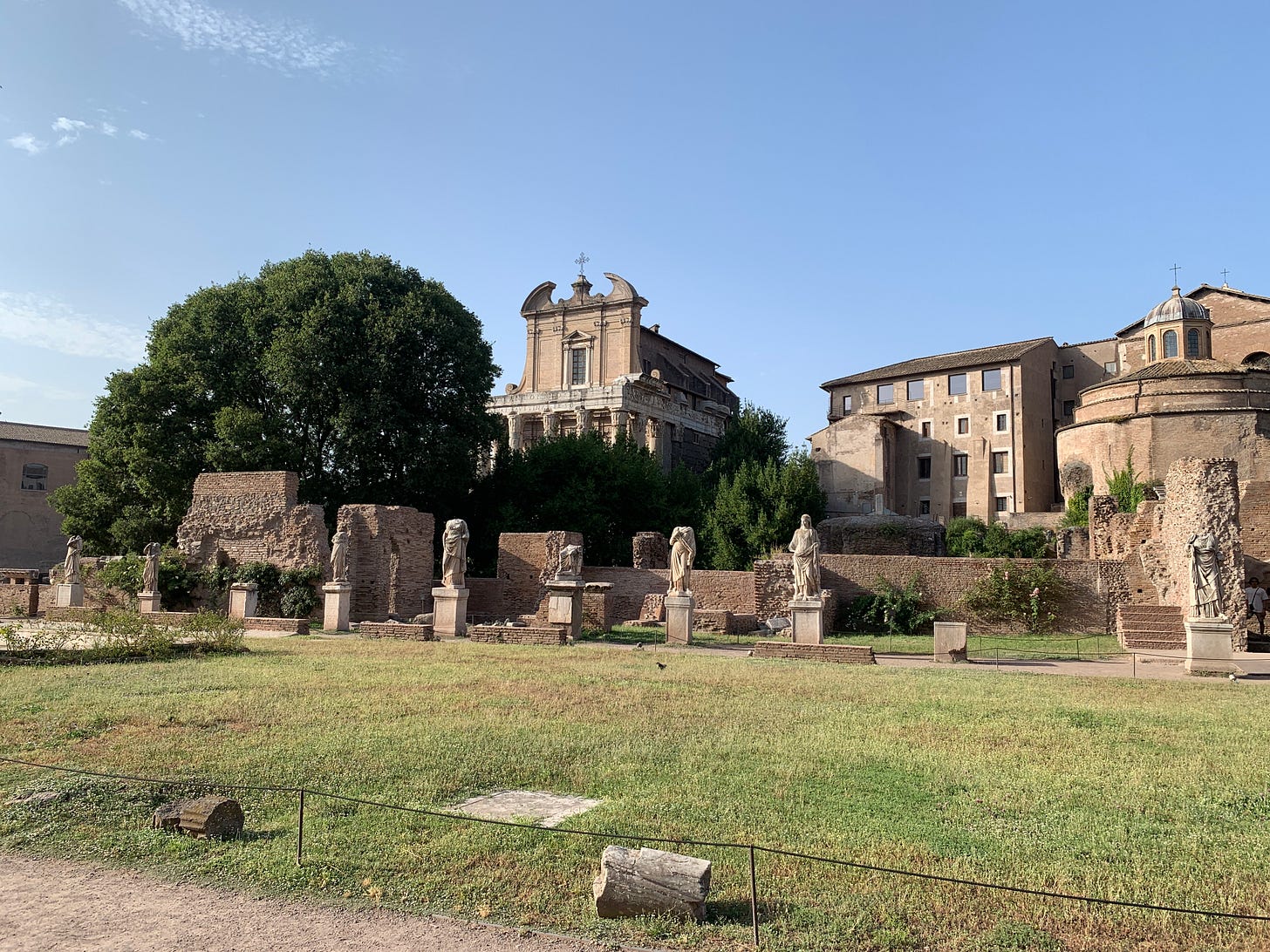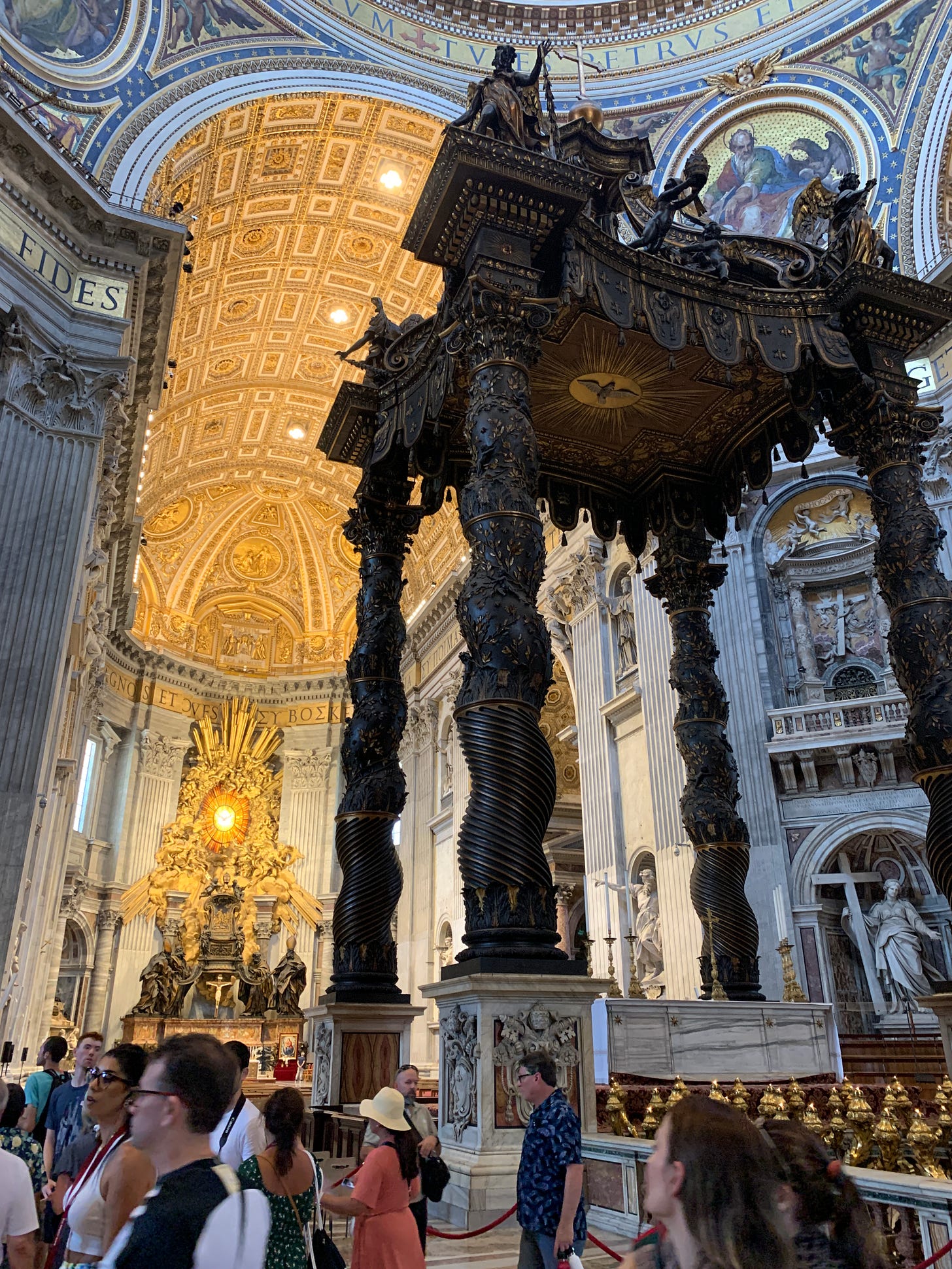Last month, I spent two weeks in Italia, one of my favorite places on the planet. This week’s OOO features highlights from Rome and Naples (where I spent the first half of my trip). Next week, I’ll include my recommendations from Milan, Turin, and Lake Como.
Roma
Rome is hands down my favorite city in the world. I love Venice and my hometown of New York, but there is something so special about Rome that I dream about it and read about it more than anywhere else on the planet.
It doesn’t hurt to have my last name plastered everywhere either.
Here are some highlights from my various trips to Rome over the years.
Things to Do - Common Sense
The Roman Forum and the Colosseum. I studied Roman history in college, so I’m happiest in the Roman Forum. My biggest recommendation (other than bringing a water bottle) is to bring a written guide with you to contextualize what you’re seeing because there are a LOT of structures in the forum. Things not to miss: the Home of the Vestal Virgins, the grave of Julius Caesar, and the navel of the City of Rome. You get a dual ticket to the Roman Forum and the Colosseum, and even though the Colosseum is jam packed with tourists, the building has a fascinating history of its own, and it’s worth reading the panels inside the structure. I would love to do an after hours tour of the Colosseum with a guide to go into the lower level at some point.'
Tour of the Vatican Museums, the Sistine Chapel and St. Peter’s Basilica. I was overwhelmed by the sheer amount of art at the Vatican both times I’ve visited. The tours are fast (unless you have a private guide) and the museums are crowded, and I would highly recommend signing up for a “before it opens” or “after hours” tour or ticket if you can or going off season. You can send postcards from the Vatican’s own post office, which is pretty cool if that’s your thing, but bring a pen because otherwise you’ll have to buy one for €2. If you go to the Vatican in the morning, head to Raffaello’s Bar beforehand for a proper Roman breakfast (caffe e cornetto standing up).
Pantheon. It’s worth going inside once, and read about the history of the building before you go. You don’t need a ticket ahead of time if you line up to get in first thing in the morning (otherwise, you may be waiting for a while).
Trevi Fountain. It will be packed with tourists, so go in on the left side. Throw a coin from your right hand over your left shoulder, any you’ll be sure to return to Rome. It really is just beautiful.
Piazza Navona. I was completely blown away by how beautiful this piazza is, especially after skipping it my first trip (I thought—what’s the fun of a piazza?!). Piazza Navona has beautiful fountains and architecture which are illuminated in the morning and at golden hour, and it is a fun place to people watch.
Things to Do - Might Not Have Heard Of
Domus Aurea. The Domus Aurea is an active archaeological site excavating the Golden Palace of the famed emperor Nero. My tour of the Domus Aurea last summer is one of the best I’ve ever been on, and a visit to the site is the number one thing I would recommend to history buffs who are visiting Rome. The Domus Aurea was built after Rome’s great fire of 64 CE and dominated the Oppian Hill and the area where the Colosseum now stands. After Nero’s death, the Domus Aurea was stripped of its fine materials, filled with earth, and built over; the rediscovery of the complex led to the development of the grotesque style of painting. It’s fascinating, and you should go.
Chiesa del Gesù. I have visited quite a few churches in Rome, and the Chiesa del Gesù is one of the most stunning. The ceiling itself is a sight to behold; the figures in the center panel are not confined within the bounds of a traditional fresco and spill out onto the gilding around it. I’m obsessed. The Chiesa is also home to the Baroque Machine, which is a special thing to see if you are in the neighborhood at 17:30 each day.
Castel Sant’Angelo. You have probably seen the outside of the Castel Sant’Angelo, especially if you’re crossing the Tiber to get to the Vatican, but it’s worth a visit inside too. The structure started as Hadrian’s mausoleum, and subsequently served a half dozen other purposes; you’ll pop in one room and it contains an air shaft to a dungeon, while the next is a magnificent receiving room the pope used while he sheltered there during one of the sacks of Rome. It’s the type of chaos I need more of in architecture. The top of the Castel Sant’Angelo also has some of the BEST views of the city.
Doria Pamphilj Gallery. I am a sucker for overly ornate homes of wealthy families filled with more art than they know what to do with, and the Doria Pamphilj Gallery delivers. It’s basically a visual assault of gilding, oil paint, and marble. *perfection*
Basilica di Santa Maria in Cosmedin. The Basilica is home to the Bocca della Verita, which you may remember from “Roman Holiday.” Beyond that, the church was first built in the 8th century and played an important role in papal and Church history. It is also home to a mosaic from the old St. Peter’s and the alleged skull of St. Valentine.
Places to Eat and Drink
Contrario. Excellent wine and excellent pasta. Easily the best meal I had in Rome this past trip. I was worried about its proximity to the Colosseum, but I needn’t have. I particularly loved the crostini con stracciatella e tartufo nero fresco—watching our server shave a truffle over my food was a true pleasure.
Milea. An excellent cocktail bar in Trastevere that also serves shockingly good small plates. I loved their Lavender Sour; my husband was happy to have a Last Word, despite the chartreuse shortage. An evening stroll around Trastevere afterward is necessary.

Ciampini. I visit Ciampini every time I’m in Rome. It’s a great place for aperitivo (a cocktail and a small plate of sandwiches and other snacks) that seems to be frequented by Roman professionals after a long day at work. The signature Ciampini cocktail is an improvement on the Negroni.
A note on pizza: Roman pizza (especially pizza al taglio) and Neapolitan pizza are different, so read about what you’re ordering and don’t be surprised if your pizza is square cut.
Along those lines, Roman cuisine is different from the general Italian cuisine you’ll see in America (Italy is *very* regional), and if you see a place boasting “Italian food” in English (especially one with a menu with pictures posted outside and someone trying to lure you to a table), that’s a tourist trap. Common Roman cuisine includes: pasta alla carbonara, tripe, cacio e pepe, artichokes (I prefer them fried), and a LOT of pork cheek.
Other Things
Castel Sant’Angelo Luxury Rooms. I’ve stayed here twice. The rooms are beautiful and clean (with excellent air conditioning, which was a help during the heatwave), and the location can’t be beat. If you don’t mind checking yourself into the hotel using codes, this is a place worth looking into.
Nasoni. Nasoni are water fountains throughout the city of Rome that are continuously flowing. The water comes from aqueducts, and is not only safe to drink (I’ve seen plenty of Romans drink from them), but also usually pretty cold. Once you see one, you’ll see them everywhere.
The Knights of Malta Keyhole. If you’re in the area, visit the Knights of Malta Keyhole. Try not to see an image of what it is before you go so as to not spoil the surprise, but nothing is like seeing it in person.
Via Giulia. I love walking down the Via Giulia during golden hour. It’s quiet and beautiful, and the ivy covered bridge close to the Tiber is just lovely.
I still have plenty of things I want to do on my next trip to Rome: the Etruscan Museum, the Borghese Galleries, Basilica Santa Maria Maggiore, Palazzo Colonna, Augustus’s Mausoleum, and the Museo dell'Ara Pacis. I would also love to take a guided tour of the Tempio Maggiore of Rome and the Jewish Quarter. I also can’t wait to dine at Da Bucatino.
Napoli
I didn’t spend enough time in Naples either time I’ve visited; I would one day love to see an opera at the Teatro di San Carlo, visit the Castel Sant’Elmo, take a tour of underground Naples, and even take a trip out to see the Royal Palace of Caserta. Until then, here are some of my favorite things I’ve done and seen while in Naples.
Museo Archeologico Nazionale di Napoli
You must visit the MANN while in Naples. It has an incredibly fine collection of antiquities, including frescoes from Pompeii, the Farnese marbles, an Egyptian collection, the Secret Gallery of artwork that would be banned by most American politicians, and most importantly, the Alexander Mosaic depicting the Battle of Issus. This museum is an absolute treasure.
Pizza at the Antica Pizzeria Port’Alba
I take pizza pretty seriously, so I had to visit the oldest pizzeria on the planet this most recent trip to Naples (last time, the line was wrapped around the corner, and I was in the kind of mood where it was important to get food in me immediately, so I didn’t get the opportunity). It was perfect. 10/10. No notes.
Another note on pizza: The Associazione Verace Pizza Napoletana provides rules as to what constitutes “True Neapolitan Pizza,” and a number of restaurants in the USA (including two of my favorites in DC: Menomale and Il Canale) have the designation.
Duomo Di Napoli
I was absolutely floored by the Duomo di Napoli, the seat of the Archbishop of Naples. The Duomo holds important relics and artifacts of St. Gennaro, including his blood (which liquifies!). The frescoes throughout the Duomo are amazing, and it is home to my new favorite chapel: the Minutolo Chapel, a charmingly Gothic space that was even mentioned in the Decameron. If you’re in Naples, you must go.
Day Trip to Pompeii
If you have the opportunity to go to Pompeii, do it. A major trading hub during the Roman Empire was completely frozen in time and preserved, and archaeologists and visitor alike can get some insight into daily life in Ancient Roman culture. You can get tickets by booking a tour from a variety of tour companies, or you can buy your own tickets, take the train down from Naples, and make your own way around the site. Either way, bring a written guide to contextualize what you’re seeing.
A few notes on Italy
When traveling to Italy, regardless of gender, please make sure that you dress to cover both your knees and your shoulders if you plan on visiting churches. This is a cultural practice in Italy, and many churches will ask you to leave (or provide you with a goofy looking gauze wrap) if you do not. I have found that midi dresses in natural fibers like linen and cotton keep you way cooler than shorts (I lived in this one from Quince this past trip), and you can just use a scarf for your shoulders in a pinch.
Many (quality) restaurants close for “Reposo” or “La Pausa” between about 2:30pm and 7:00pm, so plan to eat your meals accordingly.
Buy your tickets to tourist sites ahead of time. Most of the time, they will sell out long before your plane touches down.
Please attempt to learn and use some Italian (using phrasebooks can really help, and Duolingo provides a nice base) when interacting with Italians. I think it’s just good manners, and Italians clearly appreciated it every time my husband and I did.
That’s it! Have a great rest of your week!













Loved this travelogue so much!
This is an incredible post!!!